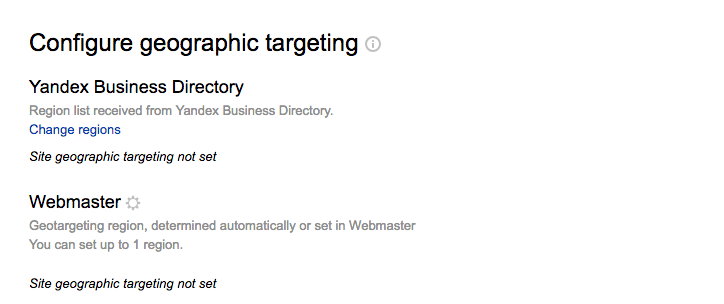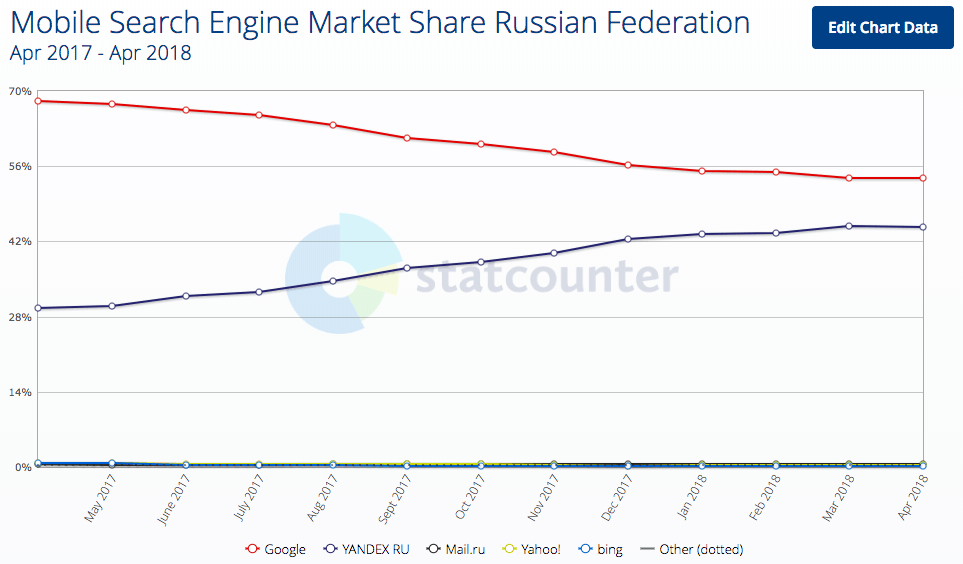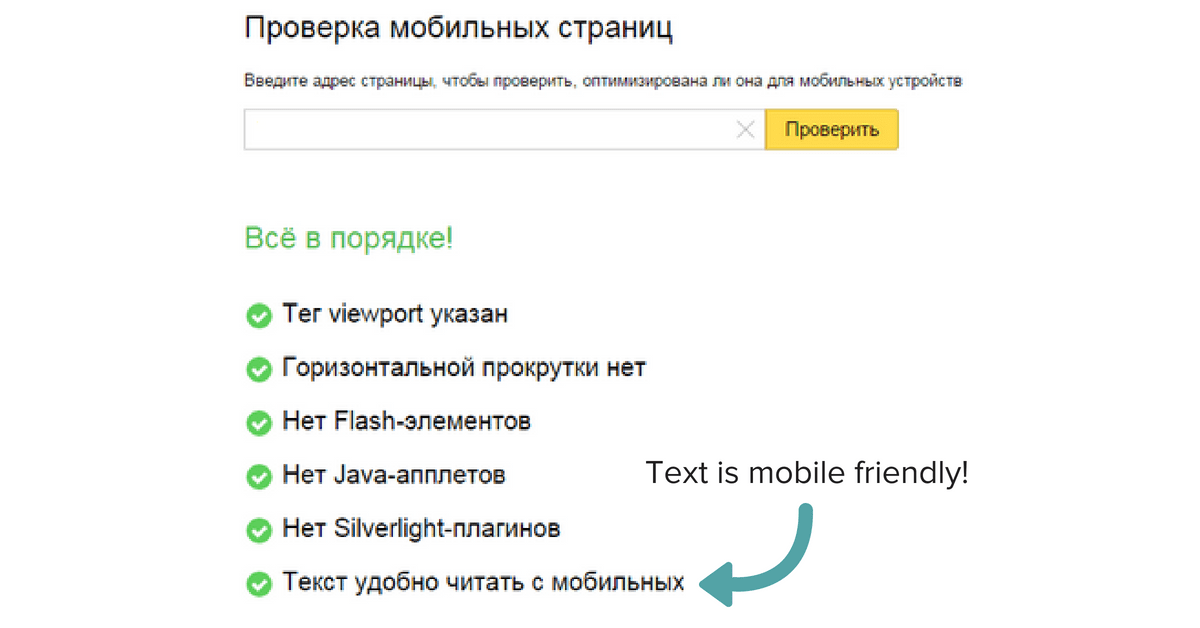While Google has a strong presence in Russia, it’s vital that your SEO strategy takes Yandex into account.
Yandex is the leading search engine in Russia (by blended market share), and due to recent legal changes (Google got slapped in Russian courts), they’ve also closed the gap on mobile.
More than just a search engine, Yandex also provide a browser (YaBrowser), email, news, maps, paid advertising, and translator services to the Russian market, as well as in Belarus, Kazakhstan, the Ukraine, and Turkey.
 Yandex offers a number of free services, similar to Google.
Yandex offers a number of free services, similar to Google.Yandex Technical SEO
While there are a number of similarities between Google and Yandex, the Russian engine has its own set of rules and nuances that need to be taken into consideration when designing and developing your Russian website (or alternate version).
| Element | Importance |
| Header Tag | Very Important |
| Title Tag | Very Important |
| Meta Keyword Tag | Important |
| Keywords in URLs | Very Important |
| Internal Linking Structure | Somewhat Important |
Getting Indexed in Yandex
Google has spoiled us with their Caffeine update and how quickly they discover and index fresh content.
Yandex, however, takes a little longer to discover new sites and URLs.
To get content indexed more efficiently within Yandex, it’s important to submit sitemaps via Yandex.Webmaster.
JavaScript & CSS
In November 2015 Yandex reported via their webmaster blog that they have started to crawl JavaScript and CSS, and in a later support article they covered how Yandex treats AJAX websites.
In short, Irstlena Pershina, an active Yandex public spokesperson on their webmaster blog, recommended the below in 2018, in response to a question about Angular, AngularDart, and whether they need server-side rendering:
A general rule: there must be static content for the robot. Irstlena Pershina, May 7 2018, 18:18hrs
Hreflang & XML Sitemaps
While the XML sitemap implementation brings a number of benefits, such as improving page load speed (as the separate hreflang tags don’t need to be read by crawlers on page load), they won’t work in Yandex.
Yandex supports only the <head> markup, so if you have a lot of language variations, you may need to revise your approach for Russia.
Page-Level Tags
Unlike Google, Yandex does support the meta keywords tag as an HTML element:
<meta name="Keywords" content="..."/>— May be used when determining the page’s relevance to search queries.
Cloaking
In 2008 Yandex introduced an algorithm with the codename Nakhodka with the aim of preventing and identifying cloaking in much more aggressive manner. Based on numerous blog posts, this appears to have worked.
Intrusive Pop-Ups
In 2012, Yandex updated its core algorithm to tackle websites with intrusive (and fake notification) pop-up windows. This was later updated in 2014 to be even stricter on pop-ups that interfered with user experience and content accessibility.
On-page SEO for Yandex
Yandex has a number of algorithms that ensure users are met with quality, useful content, matching their search intent.
This process began in 2007 through an unnamed update that introduced new ranking and variable weightings for single and multi-word search queries.
8-SP1
The unnamed update was followed in 2008 by the first officially named algorithm, the catchy 8-SPI1. During this time in Yandex’s history, older websites ranked higher because of their age and this algorithm worked to change that, to give fresher (and potentially better quality domains) more of a fighting chance to rank for top positions.
This algorithm also changed how backlinks were weighted as a ranking factor, in the sense that it lessened their power.
8-SP1 was followed by some smaller quality algorithm changes, namely Magadan (2008) which enabled the search engine to understand abbreviations, as well as start to understand the difference between commercial and non-commercial queries and content uniqueness.
AGS Filter
The AGS filter was first introduced in September 2008 and was updated in 2009, 2013, 2014, and 2015. You could refer to this as Yandex’s Panda algorithm.
The first iteration of the algorithm was primarily concerned with duplicate and low-quality content. Later updates meant Yandex could demote the rankings of websites built to drive traffic for on-page ad impressions, and penalize websites focused on selling and placing links.
Reykjavik & Kaliningrad
Reykjavik (2011) and Kaliningrad (2012) were the first steps in search personalization. Search history, cookies, and user behaviors began to influence and create personalized search results.
Yandex’s Thematic Index Citation (TIC)
Yandex uses the TIC score to analyze a website’s perceived popularity, topical relevancy, and from this infer authority. You can infer a similarity to PageRank here.
The score ranges from zero to 150,000, and a higher score means website quality is higher. However, similar to DA (Moz’s Domain Authority metric), the TIC score does not reflect how well a website ranks, nor does it count as a ranking factor.
The last major changes to how they calculate TIC came in 2016 (via this blog post), but recently all of the Yandex support pages surrounding TIC started 404‘ing and their plugin for checking TIC (Yandex.Element) now 302 redirects to a YaBrowser download page.
4TIC is very much a vanity metric, much like DA, and should be avoided as a campaign KPI.
However, if you want to improve your TIC score, you need to make sure that you have:
- Good internal links that add value to the user, and not randomly linking the first instance of each word on a page, etc.
- Write good, high-quality content that satisfies a users needs (not too dissimilar from Google).
- Make sure that the content is relevant.
Yandex Local SEO
Because of the sheer size of Russia, localized search works slightly differently than what we’re used to with Google, even in similarly big countries such as the United States.
Within Yandex.Webmaster, you’re able to specify the region that you’re targeting (if applicable), and from a user perspective, geotargeting searches are an important part of getting useful and relevant results.
Arzamas & Konakovo
In 2006, the Arzamas update allowed users to manually determine if they saw national or regional search results, and the 2009 Konakovo update saw this rolled out to more than 1,250 cities including the Ukraine, Belarus, and Kazakhstan.
Yandex checks your website’s IP, contact information (make sure this is structured and displayed clearly), and domain registration information.
If all signals here point to the Nenets Autononous Okrug region, but you’re actually targeting the Murmansk Oblast region, then you might not rank as highly in local searches.
This functionality was improved further in 2010 through the Obninsk algorithm, which also saw websites boosting local rankings with spam directory listings penalized.
Changing Your Yandex Region
As mentioned, you can set your region in your Yandex.Webmaster account. This is however only a request and isn’t taken as gospel by the search engine.
If you’re not targeting a specific region (e.g., you’re an online retailer that can ship to anywhere), you won’t be affected by Yandex’s localized search for online retail queries.

You can specify up-to seven regions within Yandex.Webmaster, but in order to do so you must be listed in the Yandex.Catalogue.
Yandex Offsite SEO
While Google’s Penguin algorithm didn’t become part of our lives until 2012, Yandex introduced their first link-based algorithm in 2005 (no official name, but it became known as the Nepot filter), with the aim of reducing the impact that link exchanges, PBNs, and other spam links being generated.
As well as link quality, the Nepot filter specifically looked for unnatural link acquisition patterns. Unofficially, this appeared to have been updated again in 2008.
Ranking Without Links
In 2013, a beta algorithm was rolled out in Moscow for some verticals (namely travel, real estate and household appliances), and it produced rankings without taking links into account.
Very little information exists about how successful the trial was, but in 2015 a new link-based algorithm named Minusinsk was launched (so we can infer that the “no links” rankings didn’t work out too well).
After the Minusinsk announcement, webmasters who had engaged in link spam tactics received notifications through Yandex.Webmaster, and the algorithm rollout saw three key impact dates:
Yandex Mobile SEO
It’s estimated that there are 80 million smartphone users in Russia. If current growth continues this will reach 93 million by 2021.
The mobile search market in Russia is also going through a turbulent time of change. In May 2017, the Russian Antimonopoly Service ruled that Google’s default Android OS was too restrictive and not in the best interest of the consumer, and forced Google to develop a widget and new Android OS to make it easy for users to change default search engine.
Given that the most recent data shows that Android holds around 70 percent of the market, this has led to a huge swing in mobile search engine market share, with Yandex gaining from 29 percent to 44 percent in the space of a year, at the expense of Google.

Vladivostok Algorithm
Yandex introduced an algorithm change with the codename Vladivostok, and this was aimed at providing a better experience for mobile users.
Historically (since November 2015), Yandex had tagged mobile-friendly websites within search results (which was roughly 18 percent of sites at the time). This was really the first “push” to make webmasters think about mobile experiences and start to plan responsive, dynamic, or m-dot websites.
Vladivostok allowed a slight grace period for websites not yet providing good mobile experiences for users, but they did see some fluctuations and a gradual decline.
One interesting takeaway from Yandex’s mobile ranking factors (which aren’t to dissimilar to mobile ranking factors we’re used to with Google – and providing great user experiences), is that in Yandex’s mobile friendly checker, these is a criteria for mobile-friendly text size.

If the font is 12px or more, it is considered to be mobile friendly. If the page has a smaller font size, it will be impacted negatively within search engine results pages.
Yandex Keyword Research Tools
A staple of any SEO campaign, keyword research for the Russian market is just as important as ever.
A number of accessible tools make it easier to conduct in-depth keyword research in the Russian market.
Yandex Wordstat
Wordstat is one of my favourite tools for conducting keyword research in Russia. It’s a part of Yandex’s paid search toolkit, and allows you to break down searches by region.
From experience, I also tend to trust the impression data here a lot more than that of the second tool in this section.
Google Keyword Planner
Given that Google is the second largest search engine in Russia (when device statistics are blended), the AdWords Keyword Planner tool works for the Russian market. It also gives more broad and extensive lists of related keywords, although relevancy sometimes suffers so the long list can require a lot of pruning back.
The search volumes provided are also, from experience, less accurate than Wordstat.
Mail.ru Keyword Tool
Mail.ru is the third largest search engine in Russia (approximately 8 percent of the market), but while the search engine itself isn’t popular the webmaster tools provided supply data on user behavioral factors, as well as breaking down keywords by user age and gender.
Combining the data from these tools, plus other suite staples such as SEMrush can really help create comprehensive keyword research lists.
Bonus: Yandex Search Operators
Search operators such as site: and inurl: can be invaluable to SEO professionals when diagnosing index issues.
Yandex also has a number of operators that differ slightly to those of Google. Good ones to keep on hand are:
- Title – Search for a given keyword within a title tag, works the same way as Google’s intitle: operator.
- Inurl=”keyword” – Works the same way as Google’s inurl: operator.
- Mime=”html/pdf/doc/ppt/xls/rtf/swf” – Searches for specific file types, for example: seo << mime=”ppt” would return results that are PowerPoint files related to SEO.
You can structure keywords into most operators and their variables in the below format:
Keyword << [Operator]=”variable”
More International Search Resources:
Image Credits
Featured Image: 360b / Shutterstock.com
Russian mobile market share, taken from Statcounter.com May 2018.
Yandex mobile checker (text size screenshot), taken by author, May 2018.
Screenshots taken by author, May 2018.
Subscribe to SEJ
Get our daily newsletter from SEJ’s Founder Loren Baker about the latest news in the industry!
